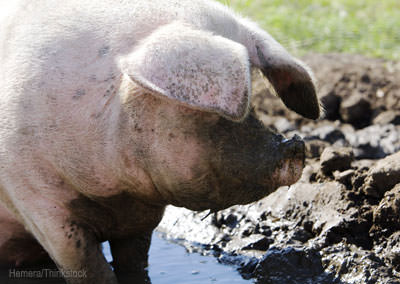
 Courtesy Hemera/Thinkstock Pigs wallow in mud to keep themselves cool in the summer because they don’t have sweat glands. |
As summer kicks into gear, you’ve likely got your hands full on the farm, but if you keep pigs, it’s essential to spend time in the pasture making adjustments to keep them cool. Unlike other livestock, pigs don’t have sweat glands so their bodies can’t sweat to cool down, explains Kristan Fretwell, who raises pastured pigs at Hunter Cattle Co. in Brooklet, Ga.
“They overheat really easily,” Fretwell says. “It’s so important to [keep them cool] especially during the summer when it gets so darn hot.”
This summer, watch for signs of heat stress in your pigs, such as increased panting, additional water intake and loss of appetite. To reduce the chance of heat-related illnesses and symptoms like lethargy, weight loss, muscle tremors and, in extreme cases, death, follow these five strategies to help keep your pigs cool.
1. Provide adequate water.
Keeping troughs filled with cool drinking water is one of the easiest ways to help pigs beat the heat. According to Mark Whitney, PhD, swine extension educator at the University of Minnesota Extension, pigs, like humans, drink water to cool down. The hotter it gets, the more important it is to ensure pigs have adequate access to an abundance of fresh, cool water.
“If there are 20 pigs in a pasture and just one waterer, the pigs will fight over it,” Whitney says. “You have to provide a sufficient number of waterers to give all of the pigs access to fresh water.”
Check the waterers often to ensure they’re working.
2. Adjust feeds.
When temperatures rise, pigs eat less. Instead of offering the same feed they’ve been getting all winter, it’s a good idea to provide a more nutrient-dense feed during the summer months.
“If pigs eat less of their winter feed, they aren’t getting the nutrients they need,” Whitney says. “You need to offer feed that is higher in protein and vitamins to help compensate for their reduction in food intake.”
Whitney suggests feeds that are high in fat and low in fiber. Too much fiber during the summer can lead to overheating.
“The digestion of fiber releases heat during metabolism, which helps keep pigs warm during the winter but it’s a disadvantage in the summer,” he says.
3. Make mud.
Pigs wallow in mud to cool themselves. To ensure there is enough mud in their pastures, Hunter Cattle Co. keeps a constant trickle of water flowing. The cool water fills the mud holes, or wallows, to give the pigs a place to cool down.
Mud offers another benefit: When it dries, it provides a protective barrier against the sun. “Mud is a pig’s form of SPF,” Whitney says.
To encourage pigs to create wallows, sprinklers are a better option than misters.
“Misters actually increase the humidity in the air and make it harder for pigs to cool themselves,” says Whitney. “Bigger droplets of water or a slow trickle from a hose is better than using misters because it keeps the humidity down.”
4. Offer shelter from the heat.
Providing shaded areas where pigs can seek cover from the sun will help keep them from overheating.
“Pigs will get a sunburn if they can’t get out of the sun,” Whitney says.
At Hunter Cattle Co., pigs are pastured in an area with a lot of tree cover. In the heat, the herd can retreat to the forest. In addition to protection from the sun, Fretwell believes pigs welcome the chance to root around for grubs, persimmons and acorns in the shade.
“If there is a choice between conventional shelter and woods, we will always go with woods,” Fretwell says.
In the absence of canopy cover, a manmade shelter or barn will do. Stick with materials like galvanized steel, which deflects the sun’s rays.
5. Install fans.
If your pigs take refuge from the heat in a barn, using fans to circulate the air on hot days can help them cool off.
“You can’t count on natural breezes to blow through the barn,” Whitney says. “A fan will generate air movement to reduce heat and humidity.”




